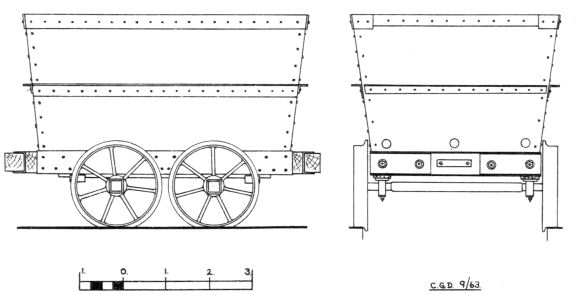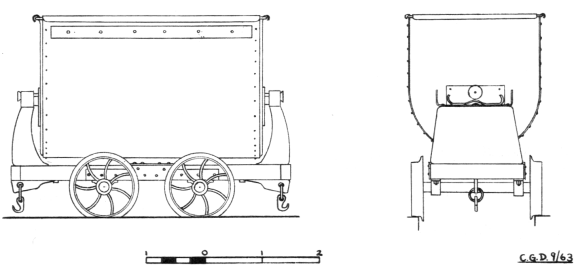
| THE INDUSTRIAL RAILWAY RECORD |
© DECEMBER 1964 |
NARROW GAUGE WAGONS
by C. G. DOWN
(2) THE SITTINGBOURNE TUB
At the Sittingbourne cement works Associated Portland Cement Manufacturers Ltd. operate about fifteen steel tubs on the 4’ 3½" gauge system which connects the claypits with the works. The tubs were constructed by Robert Hudson Ltd., of Leeds, in the early 1930‘s, but whether they came here new or second-hand from BPCM‘s Peters Works at Wouldham Hall about 1935 is not known. Having a capacity of about 70¼ cubic ft., the bodies taper towards the bottom; the area at the top is 4524 sq. in. which decreases to 3337 sq. in. at the base.
The tubs have a rectangular steel frame, 6½" deep, and a wooden buffer beam bolted to the ends. Wooden dumb buffers without any metal lacing are provided. These have curved faces to facilitate the turning of sharp curves, and are fixed to the bufferbeams in metal sockets. Coupling is effected by means of a chain with D-shackles and pins at each end.

The drawing depicts a tub as originally built. The wheel diameter is 23" and the distance between centres 26". The wheel, which has seven straight spokes, is a force (and rust) fit on to the squared axle ends, and the total width of the wheel is 4". The axles fit into crude metal sockets. mounted on wooden underframes‚ and are lubricated with a thick black grease. Buckets of this grease and sticks for its application can be seen at various points along the line.) When built, the tubs operated on light section rail but, in this was replaced by heavier rail providing a 2" running surface, To this, the wheels were replaced by ones of 5" width with seven curved spokes, and the tubs now In regular service are so fitted. At the same time the wooden underframe was shortened to about 46" in length.
Two or three tubs have had their metal bodies removed, and 2' 0" gauge skip bodies and frames mounted in their stead. This was an experiment to try to overcome the disadvantage of a tippler, but was not a success, and these variations lie disused at the works. The unmodified examples have naturally suffered during thirty years of working life, and the recent introduction of a dragline instead of a bucket chain digger at the claypits has hastened the bulging of the sides. One tub has even sustained a kink in one axle, and to see it trundling across the marshes to the pits is rather amusing.
(3) CHARLES BRAND & SONS LTD.
In their depot at Merton, Surrey, Charles Brand & Sons Ltd. have several hundred 2' 0" gauge wagons. Most of these are normal V−tippers, but some are of a slightly less common type, the U−tipper. About thirty of these U−tippers are owned by the firm. They have a capacity of 20 cu. ft.‚ and the design was produced by Robert Hudson Ltd. of Leeds, probably about 1930. The first examples were obtained by Brand in 1934, and have since been used on contracts all over the country.

The wheels are 12" in diameter and 25/8" wide; the wheelbase is 20". The inside axle bearings are mounted on small wooden blocks bolted to the frames. These are of ¼" thick metal, reinforced at the ends with an additional ¼" plate which acts as a buffer. Coupling is effected by means of two metal bars (pivoted at the centre of the frames) which have a link and hook at each end.
The body is constructed of 1/8" metal sheet, kept to a rectangular shape at the top by a ¾" diameter metal rod. At each end of the body are two short horizontal strips of metal. A dent in each fits into the corresponding hump on the body supports, providing a pivot. An alternative pin for pivoting is also provided. All the wagons are livened in black bituminous paint and smell rather in consequence.